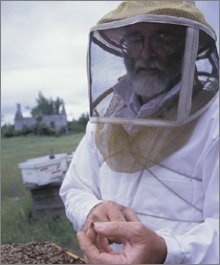Where Did All the Bees Go & What Does it Mean for Us?
The Mysterious Mass Disappearance of America's Bees
by www.SixWise.com
Honeybees are disappearing at alarming rates across the country,
leaving beekeepers and researchers alike wondering what has
caused the mysterious loss of bees.
|

Some U.S. beekeepers say they've lost up to 90 percent
of their bee colonies because of the tentatively named
colony collapse disorder.
|
Dubbed colony collapse disorder (CCD), it describes a recent
(starting largely late last fall) phenomenon in which bees
are flying off from their hives and not returning, often leaving
behind large quantities of honey and the queen bee (which
the colony cannot survive without). Most of the bees fly off
and die, while the few that are left are usually heavily diseased,
suggesting a problem with their immune systems.
"We are extremely alarmed," said Diana Cox-Foster,
a professor of entomology at Penn State University and a leading
member of the Colony Collapse Disorder Working Group.
"It is one of the most alarming insect diseases ever
to hit the U.S., and it has the potential to devastate the
U.S. beekeeping industry. In some ways it may be to the insect
world what foot-and-mouth disease was to livestock in England,"
she said.
In all, at
least 24 states have reported bees disappearing, and beekeepers
say that over one-quarter of the 2.4 billion U.S. bee colonies
have been affected, according to ABC News. Some beekeepers
report having lost up to 90 percent of their bees.
Strange Occurrences in Bee Colonies
Part of what makes CCD so mysterious is that it involves
a number of behaviors not normally seen with bee colonies,
including:
-
Normally, when bees die their bodies will be found near
the hive, or will be carried out by worker bees. With
CCD, no bodies are found, which means the bees are leaving
the colony to die elsewhere.
-
Weakened bee colonies are typically immediately overrun
by other bees or pests, looking to take the honey. With
CCD, no other bees or pests will touch the hive, even
when honey is present, for two weeks or more.
-
The hives appear normal on the outside. It's only when
beekeepers look inside that they find most all of the
mature bees have left (leaving the younger bees to develop
on their own).
Much More Than a Shortage of Honey
Every year, honeybees pollinate over $14 billion worth of
fruit, vegetable and nut crops in the United States, according
to a Cornell University study. If bees continue to disappear
at the rate they have been, there will not only be a threat
to honey stores but also to a large number of food crops produced
in the United States.
|

About 75 percent of flowering plants (including most
food crops) depend on being pollinated for fertilization.
|
Growers rent millions of bee colonies every year and depend
on them to pollinate their crops, such as Florida oranges
or California almonds. In fact, about 75 percent of all flowering
plants (such as most food crops) depend on being pollinated
for fertilization, according to a report by the National Research
Council. It remains to be seen to what extent the bee shortage
will impact U.S. crops this year.
Why are the Bees Disappearing?
Right now, nobody knows exactly why bees are leaving their
hives and dying, but there are a number of theories floating
around, including:
-
Bee Stress Levels: Tens of billions of bees are
transported across the country, in the backs of trucks,
to pollinate crops every year. Researchers have suggested
that this process is putting a high, abnormal level of
stress on the bees.
-
What the Bees are Fed: Some beekeepers feed their
bees high-fructose corn syrup or sugar, which some say
may be harming the bees' health.
-
Genetically Modified (GM) Crops: GM crops, in
particular Bt corn, have been suspected of causing CCD,
according to the Colony Collapse Disorder Working Group.
- Radiation from cell phones: A German study found
that radiation from cell phone towers may be disorienting
bees and causing them to die.
"When bees are exposed to signals from cell phones,
they can't find their way," said Dr. George L. Carlo,
chairman of the Safewireless Initiative, in an ABC News
article. "It gets no nutrition and it consequently
dies."
-
Pesticides: Researchers are investigating a group
of pesticides that have been banned in some areas in Europe,
which could potentially be interfering with bees' ability
to find their way back to their hives.
-
Others: The Colony Collapse Disorder Working Group
is also looking into a variety of other possible causing,
such as chemical residue/contamination in the wax, food
stores and bees, pathogens or parasites in the bees, lack
of genetic diversity and lineage of bees, queen source
(many farmers purchase queen bees from varying locations),
and antibiotic use.
Until researchers are able to determine the reason so many
bees are disappearing from America, the Colony Collapse Disorder
Working Group is asking all beekeepers to fill out the online
survey at www.beesurvey.com
to help them gather as much information as possible about
this potentially devastating issue.
Recommended Reading
The
Worldwide Threat to Coral Reefs and Why It Should Matter to
Everyone
Why
Banned Toxic Substances Diazinon & Dursban are Still In
Use Today: An Interview with Environment
Sources
ABC7Chicago.com
April 16, 2007
The
Independent March 1, 2007
The
New York Times February 27, 2007
WashingtonPost.com
February 11, 2007
Mid-Atlantic
Apiculture Research and Extension Consortium